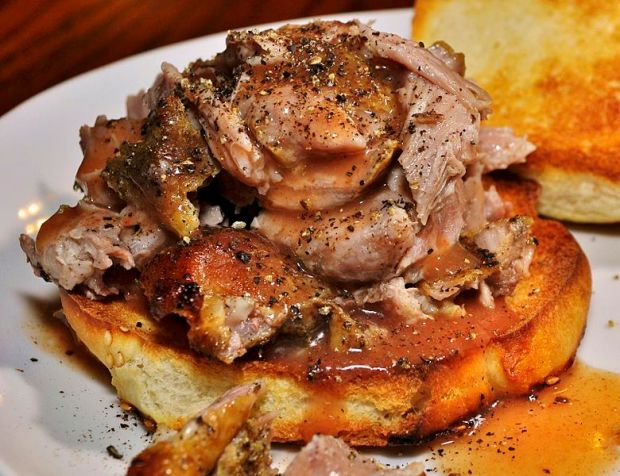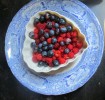
Click on link for my version of Geoffrey Holder’s roast.
Note: Leftovers make excellent sandwiches.
Click on link for my version of Geoffrey Holder’s roast.
Port of Spain, the capital of the Trinidad Tobago island nation, is a blur in my mind. I was there in my early twenties. That was the first time I left Brazil. I was terribly disappointed that rather choosing tMilwaukee, Wisconsin, as base camp, my employer, the Westinghouse Teaching Corporation, decided that the Caribbean as the best place to train prospective Peace Corps Brazil volunteers Fool that I was, I did not think that little islands near small Spanish speaking countries were sufficiently different from coastal northeastern Brazil where I lived the time. I wanted a big change, not another day at the beach. Luckily, the friend with whom I traveled had family in Belem do Para, at the edge of the Amazon. She invited to stay with them for a couple of days before flying to Port of Spain. It was then that I begin to discover my own country. Other discoveries would follow.
In Belem, I saw Native Brazilians for the first time. In my profound ignorance, I assumed they were Asian. It never occurred to me that Marajo Island, where a pre-Columbian civilization flourished between 400 BCE and 1600 CE, was a skip and a hope away. I made no effort to go to the Goeldi Museum which houses splendid Marajoara artifacts. Whatever did I do with myself amid such cultural wealth? I visited with my hosts, walked around in the daily drizzle that falls daily at the edge of the Amazonia. I ate crimson acai juice with manioc flour, tasted a few of the myriad of flavors of ice cream made with tropical fruit and gazed at the glorious examples of the florid architecture made possible by the Rubber Boom .
I must have been singularly unobservant to keep no clear memory of Port of Spain. Tere I was, a stranger in paradise, wondering blindly amid crowds that included descendants of African, Chinese, Indian, Japanese, Syrian, Lebanese and Tamil immigrants. All that I remember clearly is having ordered the wrong to go with red snapper. By comparison, the couple of months I spent in Charlotte Amalie left a more lasting impression. I was aware that Blackbeard’s Castle—formerly Skytsborg Tower–and Forth Christians were remnants of a Dutch and Dano-Norwegian past. What I missed entirely, was the Saint Thomas Synagogue, the second-oldest in American soil. I also missed any evidence of Camille Pisarro’s presence in Saint Thomas. Many years later, after I saw his paintings at the National Gallery of Art in Washington, DC, his connection with Charlotte Amalie came as a surprise. It am not sure whether he attended the local synagogue. His father, a Portuguese Jew, broke with Jewish tradition when he married his uncle’s widow. In the ensuing scandal, the Pisarros were banned from worshiping at the synagogue and their four children declared illegitimate. It took twelve years for the Beth Din to relent. By then Camille Pisarro was on his way France where eventually chose art over commerce.
In Charlotte Amalie I saw none of Pisarro’s luscious paintings of food. I frequented no Sephardic households and consequently missed out on an introduction to Sephardic-Caribbean cuisine. The cooking staff hired by Westinghouse was from Guadeloupe. Its repertoire was heavy on French classics. I recall, particularly, the chef’s splendid Canard a l’Orange. Meals I had at a local restaurant were not memorable except for conch, a delicacy previously unknown to me. Many years later, after I moved to Fargo, North Dakota, I discovered Caribbean cuisine through GEOFFREY HOLDER’S CARIBBEAN COOKBOOK. A spicy roast recipe from that cookbook would become one of my dinner party specialties after I moved to West Virginia. My circle of friends included college students from India, Pakistan, Syria, Iran, Morocco, and Paraguay. Few of us ate pork and some did not eat beef. Other than that, we had many recipes in common. When met for monthly for potluck dinners, we astonished each other with dishes that replicated themselves in distant parts of the world. For example, pasteis, meat or cheese turnovers popular at Brazilian celebrations, were identical to Indian samosas and not all that different from Syrian sfiha. Iranians, Pakistani, Paraguayans all made rice dishes not that different than those we Brazilians enjoyed. The world seemed much cozier then, at least around the dinner table.
I’ve used Geoffrey Holder’s recipes more often after I settled for good in a small town that is only a couple of hours to Washington, DC. That makes the Kennedy Center part of our neighborhood if one thinks in big city terms. That is not too long a distance to travel for capital entertainment. That is how I was able to see Geoffrey Holder dance in a performance of “Kismet.” Eartha Kitt was one of the principals, but the enormously tall–6’6” tall—and supremely graceful Holder stole the show. , Today he is better known for his Seven-Up—the Uncola–commercials and his film appearances as Baron Samedi in “Live and Let Die,” as Punjab in “Annie,” and as Nelson in Eddie Murphy’s “Boomerang.” He had many other talents, such as choreography, painting, photography and writing. I remember him as a marvelous presence on the stage and as the author of a wonderful cookbook in which he collected recipes from his native Port of Spain.
